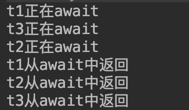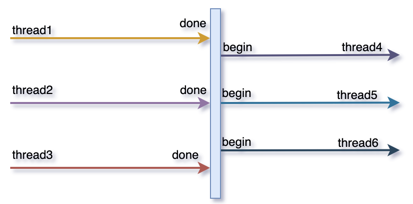CountDownLatch源码分析
简介
CountDownLatch,我们称之为闭锁或倒计时器,它允许一个或多个线程必须等待其他线程全部执行完之后才能执行。例如:部门周会,必须等所有人到齐才能开。其本身是基于AQS的共享模式实现,示例图如下:
方法摘要
| method | description |
|---|---|
public void countDown() |
在许可可用之前阻塞当前线程。 |
public void await() throws InterruptedException |
阻塞式地等待,并且是响应中断的 |
public boolean await(long timeout, TimeUnit unit) throws InterruptedException |
带超时等待,可响应中断 |
源码分析
private final Sync sync;
sync是CountDownLatch的核心属性,它继承自AQS,同时重写了tryAcquireShared和tryReleaseShared,以完成具体的同步状态的获取与释放的逻辑。
private static final class Sync extends AbstractQueuedSynchronizer {
private static final long serialVersionUID = 4982264981922014374L;
/**
* 构造方法里面用`count`值初始化`AQS`里的`state`,来表示计数器的总数
*/
Sync(int count) {
setState(count);
}
int getCount() {
return getState();
}
/**
* state为0表示尝试获取同步状态成功,其他情况均为失败
* 没有使用入参
*/
protected int tryAcquireShared(int acquires) {
return (getState() == 0) ? 1 : -1;
}
/**
* 每调用一次,state减1,直到state值为0表示释放同步状态成功
* 自旋是为了防止CAS失败,没有使用入参
*/
protected boolean tryReleaseShared(int releases) {
for (;;) {
int c = getState();
if (c == 0)
return false;
int nextc = c-1;
if (compareAndSetState(c, nextc))
return nextc == 0;
}
}
}
countDown方法
public void countDown() {
//每次
sync.releaseShared(1);
}
await方法
public void await() throws InterruptedException {
//调用可中断的获取同步状态方法
sync.acquireSharedInterruptibly(1);
}
public boolean await(long timeout, TimeUnit unit)
throws InterruptedException {
//调用可超时的获取同步状态的方法
return sync.tryAcquireSharedNanos(1, unit.toNanos(timeout));
}
示例
模拟一下刚开始那张图的场景:
public static void main(String[] args) {
CountDownLatch latch = new CountDownLatch(3);
//新建三个线程
for (int i = 1; i < 4; i++) {
new Thread(() -> {
try {
Thread.sleep(3000);
} catch (InterruptedException e) {
e.printStackTrace();
}
latch.countDown();
},"r" + i).start();
}
for (int i = 1; i < 4; i++) {
new Thread(() -> {
try {
System.out.println(Thread.currentThread().getName() + "正在await" );
latch.await();
System.out.println(Thread.currentThread().getName() + "从await中返回" );
} catch (InterruptedException e) {
e.printStackTrace();
}
},"t" + i).start();
}
}
结果

分析
刚开始,
state的初始值为3,此时t1,t2,t3调用await(假设按照这个顺序,实际情况可能入队顺序不一样),await调用acquireSharedInterruptibly,接着调用tryAcquireShared,因为此时state值肯定不为0(r1,r2,r3三个线程执行3s),所以tryAcquireShared返回-1,于是执行doAcquireSharedInterruptibly,然后调用parkAndCheckInterrupt被挂起,此时t1、t2、t3均加入同步队列,且对应的前驱waitStatus值置为-1,等待被唤醒。
然后假设此时
r1调用countDown,然后调用releaseShared,接着调用tryReleaseShared,state值-1变为2,不等于0,返回false,直到r3线程调用countDown完毕之后,state变为0,返回true,此时调用doReleaseShared,然后调用unparkSuccessor唤醒t1,最后相继唤醒t2、t3。



 随时随地看视频
随时随地看视频



